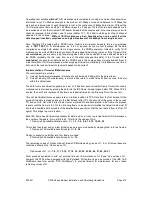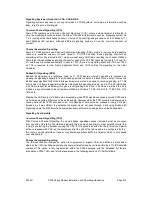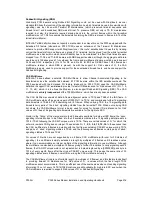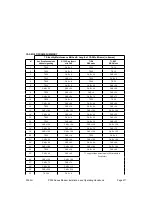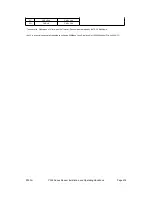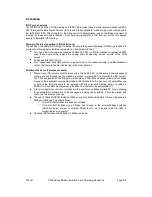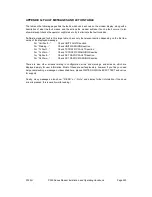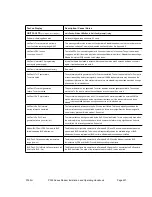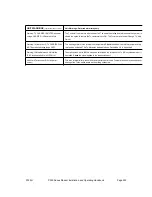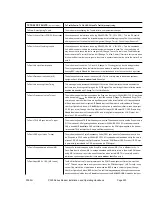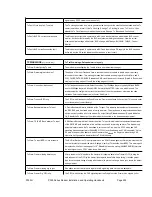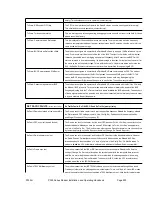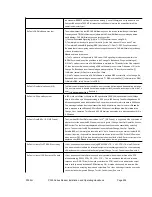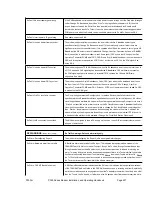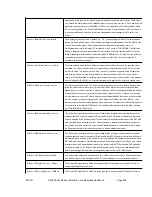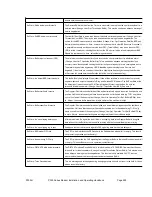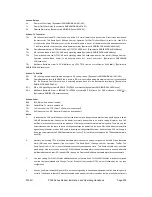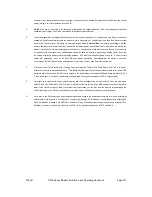
P300H
P300 Series Modem Installation and Operating Handbook
Page 228
catastrophic failure (and the correspondingly more significant backward Alarm above). The Modem
only detects this alarm when the Rx baseband is set to use the Insert mux in a G.732 mode and CAS
signalling has been selected (or 2048k IBS G.732 0% overhead mode with CAS is enabled). Read
the text corresponding to Rx Fault: CAS Multiframe sync los to determine why a CAS multiframe is
in use over satellite and Check the three items listed against this message on the Tx path of this
modem.
Rx Warn: Back' alm 1234 from satellite
The display may show numbers or dashes (eg -2-4") corresponding to which of the four backward
alarms are active at the Rx Input. This indicates that equipment downstream of the TRANSMIT path
(ie the distant end Rx path or further downstream) has failed and is returning an alarm. In
Multidestinational circuits this may NOT correspond to the Tx path of THIS MODEM. The fault may
be due to
any
receive downstream equipment, but
could
be due to the relevant modem Tx output
failing.
Check
the relevant modem Tx path indicates OK,
Check
the Tx IF output from the modem is
connected to the upconverter equipment and onwards, monitor the Tx carrier (or distant Rx if
possible) with a spectrum analyser.
Rx Warn: O/p clk fail=<source>, now PLL
The clock selected as the Receive data output clock, (where <Source> shows the specified clock)
has failed. The modem has switched to using a backup clock generated by the Rx PLL to preserve
the receive traffic. This fault only occurs if the <source> is the same frequency as the Rx data rate,
otherwise the clock is not used directly instead it is rate converted by the Rx PLL, and it s failure
results in the fault described immediately below instead. Refer also to the description of the dialogue
under (Change, Rx, Buff/Clk, Rx Clock) to determine which signal the PLL uses as a backup clock.
Rx Warn: No clk ref=<source> , now int'
The reference specified for the PLL, which generates the Rx output clock (or backup Rx clock) has
failed; the modem has switched to using the internal 1PPM reference to keep the clock available.
Check
the clock <source> specified is present. If a station clock is specified as available the modem
will use this as the <source> to generate the
backup
Rx output clock even if Station not specified
as the
primary
source on the Rx Clock Mode screens.
Check
that the Station clock is still connected
as it is a common mistake to change the Rx Clock Mode to something other than Station , then
disconnect the station clock assuming the modem will not use it, whereas the modem will always use
it in preference to the internal 1PPM clock if it is has been told a station clock is available. (Change,
Rx, Clock/Buff, Station Clock Input).
Rx Warn: Back' alm received at ins' mux
This fault will only be displayed if the modem if fitted with an interface which provides four ports for
separate input and output of separate Tx/Drop and Rx/Insert PCM bearers. It indicates a Backward
Alarm is detected at the Rx bearer Input. This indicates that equipment downstream of the RECEIVE
path has failed and is returning an alarm. This may be due to
any
receive downstream equipment,
but
could
be due to the modem Rx output failing.
Check
the modem Rx path indicates OK,
Check
the Rx data output from the modem is connected to the downstream equipment.
Rx Warn: MF Back' alm Rx'd at ins' mux
This fault will only be displayed if the modem if fitted with an interface, which provides four ports for
separate input and output of separate Tx/Drop and Rx/Insert PCM bearers. It indicates a Multiframe
Backward Alarm is detected at the Rx bearer Input, this indicates that equipment downstream of the
RECEIVE path has failed to find Multiframe sync and is returning an alarm. The Modem only detects
this alarm when the Rx baseband is set to use the Insert mux in a G.732 mode and CAS signalling
has been selected. On the Rx path, if the Insert Mux bearer is set to Generate, then
check
the Rx
path is also utilising CAS, otherwise it will generate a bearer without a TS16 Multiframe.
Rx Warn: X.50 Back' alm from satellite
This indicates the distant end equipment has an X.50 fault and is returning an X.50 backward alarm.
See the description for the message Rx Fault: X.50 de-stuff sync lost for a further description.
Rx Warn: RF sig too low, now <-71dbm>
The Receive RF signal level is below the range specified for this equipment. Increase the level to
ensure specified performance is met.
Rx Warn: RF Sig too high, now <-19dBm>
The Receive RF signal level is above the range specified for this equipment. Decrease the level to

